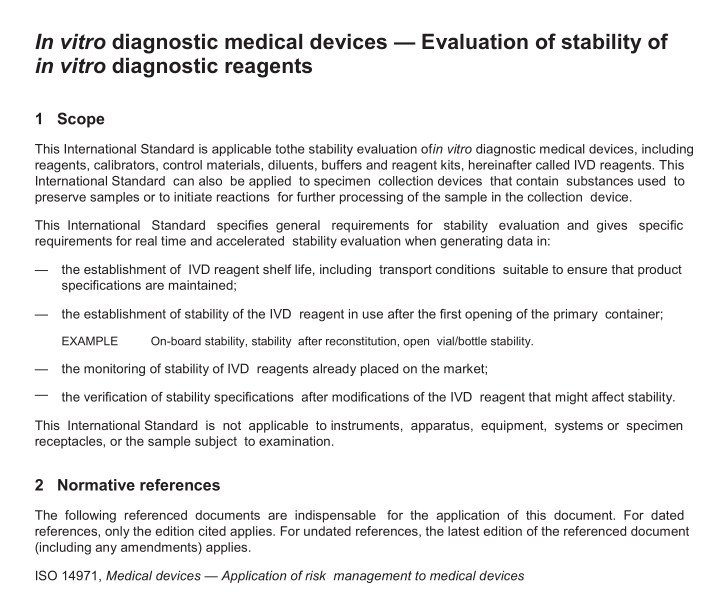EN ISO 23640:2015 pdf download.In vitro diagnostic medical devices — Evaluation of stability of in vitro diagnostic reagents
4 General requirements
4.1 General principles
Stability claims shall be justified by adequate data, considering the risks associated with the use of the IVD reagent, and with consideration of components that might be labile. Data from accelerated stability studies and/or experience gained with IVD reagents that can reasonably be expected to be comparable with regard to their stability characteristics may be taken into account for establishing initial expiry dating. Experience with similar reagents and the risk associated with the use of the device should be used to establish the basis for initial expiry dating. If, at the time of placing an IVD reagent onto the market, stability claims are based on such previous data, the claim shall be verified with real time study data.
The evaluation shall be performed on IVD reagents manufactured under conditions that are essentially equivalent to routine production conditions. If this is not the case, or if the IVD reagent is not stored in the final configuration, the manufacturer shall provide justification for the stability claims. T
he manufacturer shall establish whether there is a need for a stability monitoring programme and establish one where necessary. Evaluation at the end of shelf life can be sufficient for this purpose.
Subsequent product or manufacturing process modifications shall be reviewed to determine whether changes in the stability programme are necessary.
4.2 Protocol
Conclusions on IVD reagent stability shall be based on data that are generated in accordance with a preestablished protocol that includes:
responsibilities;
clear IVD reagent identification;
use conditions;
EXAMPLE 1 Considering variation in environmental factors, including the worst case.
objective and purpose of the evaluation;
information about the reagent samples;
EXAMPLE 2 Numbers of batches, amount, container, identification of the source, and concentrations.
potential influence of critical components;
NOTE “Critical” is meant with respect to stability.
storage conditions recommended for the reagent samples;
EXAMPLE 3 Between 2 °C and 8 °C, less than 20 °C.
simulation of transport;
intervals between examination time points;
examinations to be performed at the end of each interval;
EXAMPLE 4 Procedure and extent of examinations.
— the number of examinations to be performed with an IVD reagent, which depends on the precision of the test methods used (considering the variability which might be encountered due to equipment and IVD reagents);
the duration of the stability study protocol, which might include an additional confidence margin beyond the targeted stability claim;
description of the data analysis;
EXAMPLE 5 References to any statistical techniques and conditions for accepting or rejecting a data point.
acceptance criteria to be met;
interpretation of data.
The protocol shall be part of the technical documentation related to the IVD reagent.
4.3 Stability reports
Stability reports shall be prepared in order to document the study, or studies.
EXAMPLE Interim and final reports.
Reports shall, at a minimum, include or refer to:
— the protocol which was followed;
— the batch(es) involved;
— all results obtained;
— analysis of data;
— acceptance criteria with pass/fail determination;
— conclusions regarding stability.
Reports shall be maintained as part of the technical documentation related to the IVD reagent.
5 Procedures
5.1 General
5.1.1 Purpose
Procedures shall be performed to evaluate and verify the stability claims of the IVD reagent.
NOTE CLSI EP25-A [3] contains information regarding conditions and procedures that can be useful to the design and conduct of stability evaluation studies.
5.1.2 Examinations
Examinations shall be performed according to the procedures described in the protocol. The number of examinations to be performed with an IVD reagent representing a specific storage condition and time depends upon the precision of the methods used.
Examinations shall be undertaken at specified time points as indicated in the protocol. The time intervals shall be chosen to cover, as a minimum, the whole of the target shelf life. The number of time points should be appropriately chosen so that trends can be distinguished from the variability of the data.
There shall be a sufficient amount of the IVD reagent sample to be examined to last for the entire evaluation period and for any re-examination.
Stability evaluation conditions of the IVD reagent that differ from the final configuration shall be justified in the risk assessment (see ISO 14971 for guidance on risk management for IVD medical devices).
EXAMPLE Differences in reagent volumes or conducted in materials that differ from the primary reagent container.
5.1.3 Number of batches to be examined
The minimum number of batches to be examined shall depend on the objective of the evaluation as follows:
3 batches for the evaluation of a new IVD reagent shelf life (real time stability);
3 batches for the extension of an IVD reagent shelf life;
1 batch for transport simulation;
1 batch for in-use stability of the IVD reagent;
1 batch for an IVD reagent modification, if the risk assessment for the IVD reagent in accordance with ISO 14971 indicates that stability evaluation is required.
Using fewer than the number of batches required shall be justified in the risk assessment of the IVD reagent,in accordance with ISO 14971.EN ISO 23640 pdf download.EN ISO 23640 pdf download
